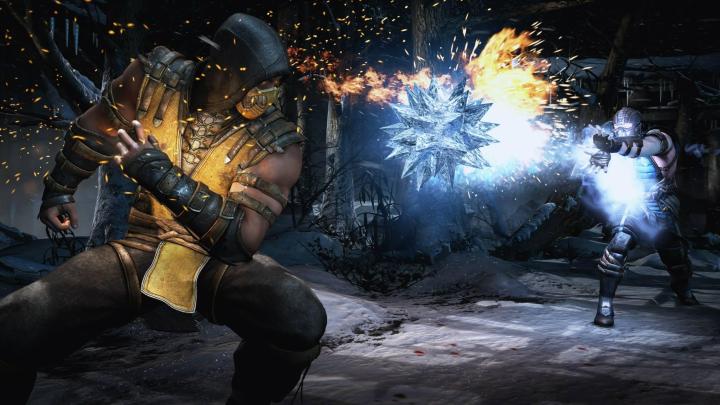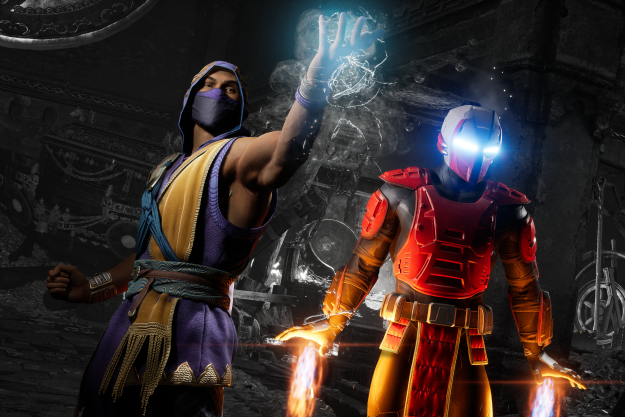There’s nothing like a little gore to lift a person’s spirits. That’s the guiding premise of the Mortal Kombat series, and NetherRealm Studios latches onto it tight in Mortal Kombat X. The X stands for 10, but there have actually been about 22 MK games since the series debuted in 1992. Though creator Ed Boon — now at NetherRealm — might be hoping we’ll forget games like Mortal Kombat Mythologies: Sub-Zero or Mortal Kombat: Special Forces. Sorry, guys; the pain is still as gut-wrenching as it feels in any great MK game. Well, maybe except for Mortal Kombat X.
If 2011’s Mortal Kombat was a return to basics (and form) for MK, X may be where it finally regains the spirit and energy it had in the mid 1990s.
Story/Concept
Say hello to the new roster. Mortal Kombat X is set 25 years after the events of 2011’s Mortal Kombat. Several main characters died in that game’s story mode, so they won’t be present here, but don’t worry; Scorpion and Sub-Zero are still kicking it. Both were in NetherRealm’s recent E3 demo, and both feel fresh. But there are a lot of new characters, too.
The MK X fighters:
- Sub-Zero: He’s back, as icy as ever.
- Scorpion: If Sub-Zero is around, Scorpion is undoubtedly back to try to kill him.
- Cassie Cage: The daughter of Sonya Blade and Johnny Cage is present, and she plays like a perfect mixture between the two classic fighter.
- D’Vorah: She’s a bug lady of sorts, shooting insects, almost flying, and stabbing with mandibles or sorts.
- Ferra/Torr: This character is a huge human brute that looks kind of like Bane, and a little girl who rides on his back.
- Kotal Kahn: He looks like an aqua version of Shao Kahn from an Aztec village.
- Raiden: Was there ever any doubt about the thunder god coming back for more?x
There are a lot more new combatants, we’re told, but they will be revealed in the future. Undoubtedly, some fan favorites will return as well.

Making everything more lively. The last Mortal Kombat got a lot of praise, but it was also criticized for being a little stiff and not adding much to the series. Boon and the NetherRealm Studios team have used the Unreal Engine 3 again this time around, but worked hard to speed up and smooth out the game. Each fighter also goes into a match armed with just one of several fighting styles, so a Scorpion vs. Scorpion showdown won’t always run through the same moves and combos over and over.
Gameplay
Smoother controls. Mortal Kombat’s complicated control scheme has always been a combination of the series’ greatest strength and most glaring weakness. Hardcore fans love memorizing combos and special moves, but casual players find it hard to pick up and play. Every new addition to MK X seems designed to simplify the kombat process, retaining some depth for fans of the series, but making it easy for anyone to pick up a controller and get gory. Special attacks appear a little easier to pull off, often requiring just three button presses, as are some fatalities.
Interactive environments. The simpler controls are aided by a very easy universal interactive environment system. NetherRealm has only shown off three arenas so far — a snowy forest, a pier, and an Outworld market — and each of them has at least a half-dozen interactive elements. These are usually things like a crate you can throw or a branch you can swing on. Pressing the R1 button when you’re near one of these items will trigger it, and the effect is the same no matter what character you’re using.
Some of the more unusual interactions involve tossing the coals out of a hot pot, wielding an old lady like a club, and branches you can swing between. For the most part, each of these interactions can only be used once per match. As simple as it sounds, this small addition really has a big impact on the matches we played, often evening out the score or turning the tide in a battle.
Stamina meters. To prevent any player from running too wild on interactive environment elements or playing run away, a stamina meter keeps everyone in check. It refreshes after a second or two, but it stops some rampant cheating. Think of it like running out of breath for a second.
Nut-destroying X-ray attacks. Organ and bone-revealing X-ray moves appeared in the last MK, but they are enhanced this time around. To use them, you need to kick your opponent’s ass for a while, building up three meters worth power. Once it’s glowing, you can hit L2+R2 near your opponent to unleash your special X-ray attack. These are the goriest, most brutal moves we’ve ever seen in a video game. One attack by Cassie Cage literally destroys the testicles and skull of her opponent. These attacks are as brutal as any fatality used to be. Seriously… crazy stuff.
Fighter variants give players choices. Mortal Kombat has toyed with alternating fighting styles before (see: Deadly Alliance), but they’ve never been executed this well. Right after you choose your fighter, you must then choose a fighting style. Sub-Zero and Scorpion have variants with swords and hammers and more traditional fire or ice specialties.
Each fighting style performs differently, but there are a few core specials that any variant can perform. Sub-Zero, for example, can always shoot a ball of ice. The goal of variants is to make for a different fighting experience. Ferra/Torr for example, has one variant where you toss around the little girl on your back and use her as a weapon, another mode where she stabs into you and gets you all jacked up on adrenaline, and a final mode where she sits on the sidelines and watches you fight with a more brawling close-range style.
Presentation
Gorgeous and smooth. This is the best-looking Mortal Kombat in years. The art design has never looked better. Legends like Sub-Zero and Scorpion are decked out, but still have their classic vibe and though the new characters are odd looking (MK characters always look odd and out of place), they do seem more well-thought out than new characters usually do in Mortal Kombat, and some of them, like Cassie Cage and Ferra/Torr may end up being classics some day.

In addition to the beautiful next-generation graphics, which bring animated 3D waves, moving environments, and incredibly detailed models, the game is much faster than 2011’s Mortal Kombat and feels smoother, likely because it runs at 1080p with a constant 60fps.
Re-invigorated love of gore. Mortal Kombat X feels like a rejuvenated take on the series, much more than Mortal Kombat (2011). Half of what made MK so successful 20+ years ago was its unabashed desire to push gore to new levels and go for broke. The last two decades have seen the rest of the entertainment world make Mortal Kombat look a little tame. Not anymore. Once again, Boon and his team are back at the forefront of violence and disgusting gore, but they do it in a way that makes it fun, like the originals.
Takeaway
The codename for Mortal Kombat X during development was “Mortal Kombat 2.” It’s a fitting title. Like the original Mortal Kombat 2 in the early 1990s, MK X takes everything we love about Sub-Zero and the gang, kicks it to 11, adds a ton of new characters, refines and enhances the fighting mechanics, and is just a bigger, better game in every way. That’s a lot to say after only seeing an early demo with a few characters and three stages, but even with this limited roster, Mortal Kombat X stands ahead of almost any MK game after just a glance.
It’s the best-looking, smoothest operating fighting game we’ve seen in a long time. Mortal Kombat is back, and it’s coming to PC and PlayStation/Xbox consoles in 2015.
Editors' Recommendations
- As Tekken 8 approaches, Mortal Kombat 1 fans are feeling burned out
- Mortal Kombat: Onslaught brings a bloody new universe to mobile
- How to unlock Havik in Mortal Kombat 1
- Mortal Kombat 1 Fatalities: how to do every character’s Fatality
- Mortal Kombat 1’s story mode shares strengths and weaknesses with superhero movies



